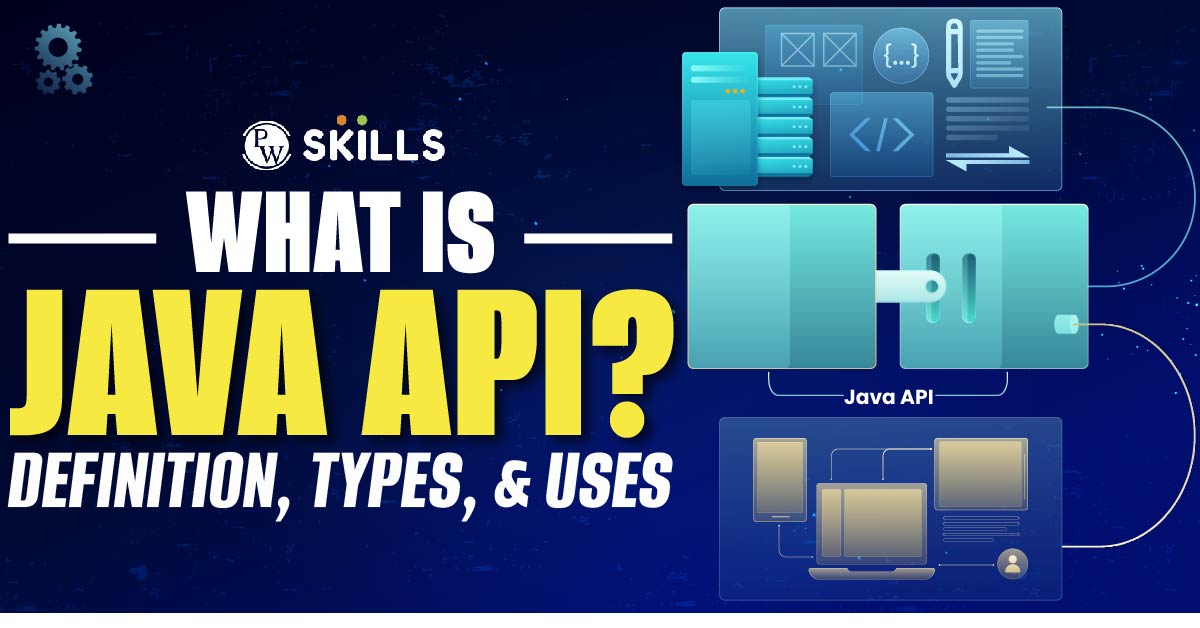API in Java allows for powerful extendibility and integration; their inner workings can seem like a black box even for experienced developers. Keep reading to know more!
API in Java: While Java is one of the most popular programming languages in the world, there is much more beyond its core syntax and language features that developers need to know to leverage its full capabilities.

At the heart of Java’s expansive ecosystem is the concept of APIs, or application programming interfaces – prewritten code that allows programs and systems to interact with each other. APIs power many modern applications by connecting backend services and databases to the frontend code we interact with directly.
From its initial release to its latest versions, Java API continues to evolve and adapt to the ever-changing technological landscape. So why not take a step further in enhancing your skills by checking out Decode Java+DSA 1.0 by Physics Wallah? Use the “READER” coupon to get exclusive discounts on this renowned course, which will surely help you become a pro in Java programming.
Don’t wait any longer and join the thousands of satisfied learners who have benefitted from this course. With determination and hard work, mastering Java API is within your reach!
API in Java Definition
An API in Java serves as a contract between different software components or systems, outlining how they can interact with one another. API stands for Application Programming Interface. It facilitates communication between different applications or software components using predefined methods and tools.
In Java, an API encompasses classes, interfaces, packages, methods, fields, and constructors. A Java API specifies how programs can request services from the Operating System. For instance, a programmer can utilize an API to obtain weather updates on a phone.
Also Read: API Full Form In Java
API Full Form in Java
In the context of Java and software development in general, the term “API” stands for “Application Programming Interface.”
An API in Java, or any other programming language, defines a set of rules and protocols that allow different software entities (like applications or libraries) to communicate with each other. It provides a set of methods and tools for building software applications, enabling them to interact with external systems or components.
In simpler terms, an API specifies how software components should interact, allowing developers to use pre-defined functions to perform specific tasks without needing to understand the complexities of how those tasks are implemented.
For instance, when you use Java’s built-in ArrayList class, you’re actually leveraging the API provided by Java to perform operations like adding elements, removing elements, or retrieving elements from the list without needing to know the intricate details of how the list operations are implemented behind the scenes.
What is API in Java with Example?
An API (Application Programming Interface) in Java refers to a collection of pre-written classes, methods, functions, and variables that developers can use to build software applications. It provides a set of rules and protocols that allow different software entities to communicate with each other. Essentially, APIs define how software components should interact.
Example:
Consider a scenario where you want to fetch weather data from a weather service provider in your Java application. Instead of writing all the code to connect to the weather service, fetch the data, and parse it, you can use a weather API.
Here’s a simplified example using a hypothetical Weather API in Java:
1) Importing the API:
import com.weatherapi.WeatherService;
2) Initializing the API:
WeatherService weatherService = new WeatherService(“API_KEY”);
3) Fetching Weather Data:
WeatherData weatherData = weatherService.getWeather(“New York”);
4) Using the Data:
System.out.println(“Temperature: ” + weatherData.getTemperature() + “°C”);
System.out.println(“Description: ” + weatherData.getDescription());
In this example, the WeatherService API abstracts away the complexities of connecting to the weather service, making an HTTP request, and parsing the JSON response. As a developer, you only need to understand the API’s methods (like getWeather) and its expected inputs and outputs.
Also Read: Anagram In Java: Examples, Programs, Solutions
Types of Java APIs
Java APIs (Application Programming Interfaces) play a crucial role in software development, enabling communication between various software components. Understanding the different types of Java APIs is essential for developers to harness the power of Java effectively. Let’s delve deeper into the various types:
1) Public or Open Java API:
- Description: These are APIs provided by Java itself as part of the Java Development Kit (JDK). They are freely available for developers to use without any restrictions.
- Usage: Developers utilize these APIs to build applications by leveraging the functionalities provided directly by Java. Examples include the Java Standard Edition (SE) API, which offers classes for tasks like file handling, networking, and data structures.
2) Private or Internal Java API:
- Description: This category refers to APIs developed by individual organizations or developers for specific purposes within their applications. They are not meant for public use and are designed for internal consumption.
- Usage: Companies or developers create these APIs to maintain proprietary functionalities, ensuring that only authorized personnel can access or modify them.
3) Partner Java API:
- Description: Partner APIs are third-party APIs that organizations offer to their partners for particular use cases or collaborations. These APIs facilitate integration between different entities, fostering seamless interactions between systems.
- Usage: Organizations use partner APIs to share specific functionalities or data securely with their business partners, enhancing collaboration and interoperability.
4) Composite Java API:
- Description: A composite API comprises multiple microservices developed using various types of Java APIs. Instead of relying on a single API type, developers integrate functionalities from different Java APIs to create comprehensive solutions.
- Usage: By combining multiple Java APIs, developers can build complex applications or systems that leverage diverse functionalities, ensuring flexibility and scalability.
5) Web Java API (Java REST API):
- Description: Web Java APIs, particularly RESTful APIs, facilitate communication between browser-based applications and external resources over the HTTP protocol. REST (Representational State Transfer) is an architectural style that uses standard HTTP methods to access and manipulate resources.
- Usage: Developers utilize Java REST APIs to create client-server architectures where Java applications provide services accessible to client applications via HTTP requests. These APIs enable interactions with various services like data storage, authentication, and more, making them essential for modern web development.
What is Rest API in Java?
REST (Representational State Transfer) API in Java is an architectural style used for designing networked applications. It leverages standard HTTP methods to access and manipulate resources. The primary goal of RESTful services is to provide interoperability between different systems on the internet.
Characteristics of RESTful API:
- Stateless: Each request from a client to a server must contain all the information needed to understand and process the request. The server does not store any client state between requests.
- Client-Server Architecture: Separation of concerns between client and server allows them to evolve independently. The client is responsible for the user interface, while the server handles the data storage and business logic.
- Uniform Interface: A standardized way of interacting with resources, typically using HTTP methods (GET, POST, PUT, DELETE) and URI (Uniform Resource Identifier).
Components of a RESTful API:
- Resources: These are the key components of the API that clients interact with. Resources are identified by URIs, and different representations (JSON, XML) can be presented based on client requirements.
- HTTP Methods: RESTful APIs utilize standard HTTP methods to perform CRUD operations:
- GET: Retrieve a resource.
- POST: Create a new resource.
- PUT: Update an existing resource.
- DELETE: Remove a resource.
- Headers and Status Codes: HTTP headers provide metadata about the request or response, while status codes indicate the outcome of an operation (200 OK, 404 Not Found, 500 Internal Server Error).
Implementing REST API in Java:
Java provides various frameworks and libraries like Spring Boot, JAX-RS (Java API for RESTful Web Services), and Jersey for building RESTful APIs. These frameworks simplify the development process by handling common tasks such as request routing, serialization/deserialization, and error handling.
Example:
Suppose you want to create a simple RESTful API to manage a list of books. You can define endpoints like:
- GET /books: Retrieve a list of all books.
- GET /books/{id}: Retrieve details of a specific book.
- POST /books: Add a new book.
- PUT /books/{id}: Update details of a specific book.
- DELETE /books/{id}: Delete a specific book.
By adhering to REST principles and leveraging Java frameworks, developers can create scalable, maintainable, and interoperable APIs that facilitate seamless communication between different systems and applications on the web.
Rest API in Java Example
Let’s create a simple example of building a RESTful API in Java using the Spring Boot framework. This example will demonstrate how to perform CRUD operations for a resource called Book.
Prerequisites:
- Java Development Kit (JDK)
- Maven
- IDE (Eclipse, IntelliJ IDEA, etc.)
Step-by-Step Implementation:
1) Create a Spring Boot Project:
You can use Spring Initializer or create a Spring Boot project using your IDE.
2) Add Dependencies:
In your pom.xml file, add the required dependencies for Spring Web, Spring Data JPA, and H2 Database (or any other database of your choice).
<!– pom.xml –>
<!– Spring Web Dependency –>
<dependency>
<groupId>org.springframework.boot</groupId>
<artifactId>spring-boot-starter-web</artifactId>
</dependency>
<!– Spring Data JPA Dependency –>
<dependency>
<groupId>org.springframework.boot</groupId>
<artifactId>spring-boot-starter-data-jpa</artifactId>
</dependency>
<!– H2 Database Dependency –>
<dependency>
<groupId>com.h2database</groupId>
<artifactId>h2</artifactId>
<scope>runtime</scope>
</dependency>
3) Create Entity Class:
Define the Book entity class with attributes like id, title, author, etc.
// Book.java
@Entity
public class Book {
@Id
@GeneratedValue(strategy = GenerationType.IDENTITY)
private Long id;
private String title;
private String author;
// getters, setters, constructors
}
4) Create Repository Interface:
Create a repository interface that extends JpaRepository to perform CRUD operations.
// BookRepository.java
public interface BookRepository extends JpaRepository<Book, Long> {
}
5) Create Controller Class:
Implement a REST controller class to handle HTTP requests.
// BookController.java
@RestController
@RequestMapping(“/api/books”)
public class BookController {
@Autowired
private BookRepository bookRepository;
// Get all books
@GetMapping
public List<Book> getAllBooks() {
return bookRepository.findAll();
}
// Create a new book
@PostMapping
public Book createBook(@RequestBody Book book) {
return bookRepository.save(book);
}
// Get a single book by ID
@GetMapping(“/{id}”)
public ResponseEntity<Book> getBookById(@PathVariable Long id) {
Book book = bookRepository.findById(id)
.orElseThrow(() -> new ResourceNotFoundException(“Book not found with id: ” + id));
return ResponseEntity.ok(book);
}
// Update a book by ID
@PutMapping(“/{id}”)
public ResponseEntity<Book> updateBook(@PathVariable Long id, @RequestBody Book bookDetails) {
Book book = bookRepository.findById(id)
.orElseThrow(() -> new ResourceNotFoundException(“Book not found with id: ” + id));
book.setTitle(bookDetails.getTitle());
book.setAuthor(bookDetails.getAuthor());
Book updatedBook = bookRepository.save(book);
return ResponseEntity.ok(updatedBook);
}
// Delete a book by ID
@DeleteMapping(“/{id}”)
public ResponseEntity<Map<String, Boolean>> deleteBook(@PathVariable Long id) {
Book book = bookRepository.findById(id)
.orElseThrow(() -> new ResourceNotFoundException(“Book not found with id: ” + id));
bookRepository.delete(book);
Map<String, Boolean> response = new HashMap<>();
response.put(“deleted”, Boolean.TRUE);
return ResponseEntity.ok(response);
}
}
6) Run the Application:
Run your Spring Boot application. You can use tools like Postman to test the API endpoints (GET, POST, PUT, DELETE) for managing Book resources.
This example provides a foundational understanding of creating a RESTful API in Java using Spring Boot for managing a Book entity. You can further enhance the application by adding validation, exception handling, and integrating with a database of your choice.
Also Read: Algorithms In Java: List, Programs, Interview Questions
Who uses Java API?
The Java API is extensively used by various entities, including:
- Java Developers: These are software developers who use the Java programming language to create applications. They leverage the Java API to access predefined classes, methods, and interfaces that simplify and speed up the development process.
- Enterprise Applications: Many large-scale enterprise applications and systems use the Java API to implement functionalities such as database connectivity, network communication, and data processing.
- Web Developers: For those building web applications using Java technologies like Servlets, JSP (JavaServer Pages), and Java-based frameworks like Spring, the Java API is essential. It provides the foundational libraries needed to build robust web applications.
- Mobile Application Developers: Although Android uses a different flavor of Java (Android Java), the core principles and some API functionalities are still derived from Java. Mobile developers building Android applications indirectly rely on the foundational concepts of Java and its API.
- Software Companies: Many software companies that develop products and services using Java as their primary language utilize the Java API extensively. This includes companies across various domains, from finance to healthcare and from e-commerce to telecommunications.
- Educational Institutions: Academic institutions teaching Java programming courses use the Java API as part of their curriculum. Students learn to leverage the API to understand core Java concepts and apply them in practical assignments and projects.
Java API serves as a foundational tool for developers and organizations across different sectors and industries that leverage Java for application development.
How to Create an API in Java?
Creating an API (Application Programming Interface) in Java involves designing endpoints that allow external entities to communicate with your Java application. APIs facilitate the interaction between different software systems. Below is a detailed guide on how to create an API in Java:
1) Define the Purpose of Your API:
Before diving into coding, clearly define the purpose of your API. Determine what functionalities or services your API will provide to its consumers.
2) Choose a Framework:
Java offers various frameworks like Spring Boot, JAX-RS (Java API for RESTful Web Services), and Spark Java, among others, to simplify API development. For this guide, we’ll use Spring Boot due to its popularity and ease of use.
3) Setting Up a New Spring Boot Project:
Use Spring Initializr (https://start.spring.io/) to bootstrap a new Spring Boot project. Include the Web dependency to ensure you have the necessary libraries for creating web applications.
4) Define Your API Endpoints:
In Spring Boot, you can define endpoints using @RestController and @RequestMapping annotations. For instance:
@RestController
public class MyController {
@RequestMapping(“/hello”)
public String hello() {
return “Hello, World!”;
}
}
5) Handle Request Methods:
Use specific annotations like @GetMapping, @PostMapping, @PutMapping, @DeleteMapping, etc., to handle various HTTP methods (GET, POST, PUT, DELETE).
@GetMapping(“/greet”)
public String greet(@RequestParam String name) {
return “Hello, ” + name + “!”;
}
6) Implement Business Logic:
Incorporate the necessary business logic within your API methods. This could involve fetching data from a database, processing information, or interacting with other services.
7) Handle Exceptions:
Ensure you have mechanisms to handle exceptions gracefully. Use @ExceptionHandler to catch specific exceptions and return appropriate HTTP status codes and error messages.
8) Test Your API:
Utilize tools like Postman, curl commands, or any API testing tool to test your endpoints. Verify if they return the expected responses for various scenarios.
9) Document Your API:
Proper documentation is crucial for developers who will consume your API. Tools like Swagger can help auto-generate API documentation in a user-friendly manner.
10) Security Considerations:
Depending on your application’s requirements, you might need to implement security measures like authentication and authorization using Spring Security or other security frameworks.
11) Deploy Your API:
Once development and testing are complete, deploy your Java application to a server or cloud platform of your choice. Ensure you handle environment-specific configurations appropriately.
Creating an API in Java, especially with frameworks like Spring Boot, streamlines the process by providing essential utilities and abstractions. However, while developing APIs, always consider factors like scalability, security, and maintainability to ensure you deliver a robust and efficient interface for your consumers.
As you embark on your journey to mastering Java API, we highly recommend checking out “Decode Java+DSA 1.0″ by Physics Wallah. This comprehensive course covers all aspects of Java API and helps students build a strong foundation in this programming language. And as a special treat for our readers, use the coupon code “READER” to avail discounts on enrollment fees.
For Latest Tech Related Information, Join Our Official Free Telegram Group : PW Skills Telegram Group
API in Java FAQs
What is API means in Java?
API in Java stands for "Application Programming Interface." It's a set of rules, protocols, and tools that allow developers to create software applications by defining interactions between software components.
What is an API with example?
An API is a set of rules that allows different software entities to communicate. For instance, the Java API provides predefined classes, methods, and interfaces to facilitate Java programming. An example can be the java.util.ArrayList class used to create dynamic arrays in Java.
What are the 4 types of API?
The four types of APIs are:
Open or Public APIs
Internal or Private APIs
Partner APIs
Composite APIs
How to create API using Java?
To create an API in Java, you can follow these steps:
Define the functionality and purpose of your API.
Design the classes, methods, and interfaces that will form the API.
Implement the API using Java programming constructs.
Document the API usage, methods, and functionalities for developers.
Distribute or deploy your API, ensuring it's accessible for other applications or developers to use.



